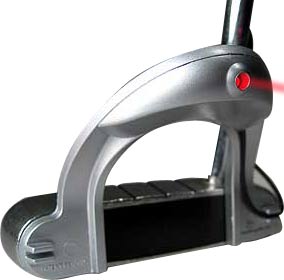Do you remember the 12 foot putt that Jack Nicklaus sank on the 17th green to win his 6th Masters at Augusta in 1986? It's probably one of the most replayed shots in golf history.
What also made this putt iconic was the "Yes, Sir!" by announcer Verne Lundquist which was synchronized with Nickaus' celebratory two arm vertical thrust into the air.
Even though this was a remarkable feat by Nicklaus, statistics show that there was some very good luck involved. Jack himself said, "I've gone back and putted that putt again a hundred times ... I've never found the ball to go left again. But it did that time."
How many 12 footers do you make, on average? In 1988, data collected by the PGA showed that the pros made a mere 26% of 12 foot putts on flat greens (Augusta's aren't very flat). The best golfers in the world at the time missed 3/4 of their 12 foot putts. Why so many?
Dave Pelz built a machine called the True Roller that reliably reproduced both line and speed on a putt. Basically a ramp, the ball rolls smoothly down the True Roller onto the green without bouncing. The ram can be aimed in any direction and speed can be controlled by are far up the ramp the ball starts.

Pelz set up the True Roller at Westchester CC on pro-am day on a freshly cut green before play started. From 12 feet, the True Roller made 73% of the putts. On the same green after the day's play, the True Roller could only make 30% of the 12 foot putts. Obviously, the condition of the green had deteriorated (in those days partially due to metal spike marks).
So a machine sinks 30% and the pros sink 26%. The pros putt about as good as it gets!
Engineers Werner & Greig found similar results with their own putting machine. They went further than Pelz and found that over a variety of distances, putts will miss laterally by a percentage of length of the putt. The amount is a standard deviation of 2%. For a 12 foot putt, 2% is almost 3 inches.
This implies that 32% of all putts that start of perfectly on-line will be 3 inches or more off-line by the time they reach the hole. Since the radius of the hole is about 2.1 inches, these putts would miss. Of the putts that roll eactly 12 feet, amost half will be wide of the hole. Only 52% of the putts stay with the hole.

Werner & Greig also researched how far putts would travel, again finding that the green is not a perfectly smooth surface and identically struck putts will not travel the same distance. They found the 2% rule also applies to distance. That is, a putt that should roll exactly 12 feet will actually have a random distance with a standard deviation of 2% of 12 feet.
So for a putt struck to roll exactly 12 feet on a perfect surface, 24% will finish short of the hole (never up never in scenario) and 24% would roll past the hole. If online, however, some of these putts would be captured by the hole. See last month's newsletter for more on which one's get captured.
Below is a three dimensional graph of the distribution of putts. The shape is a bell shaped. The red portion at the top of the bell is centered about the hole and represents the percentage of balls that would end up in that region. The bottom of the bell is blue. The bluer the region, the less likely the ball will end up there.

How can one apply these relationships to improving one's putting?
Well, the distance a putt rolls and how far off line a putt ends is dependent on the ramdom bumps of the green. A perfectly hit putt could end up short of the hole. Aiming at a point past the hole to increase the likelihood that your ball will travel far enough to get captured by the hole may not be the best strategy. It depends on the length of the putt.
I'd advise that on putts over 12 feet you definitely take the approach of minimizing the total number of putts taken as opposed to maximizing the number of one putts. To maximize the number of one putts, you'd need to attempt to hit the ball past the hole. As found by Werner & Greig, your ball will end up past this point 24% of the time, due to randomness of the green alone. As you are not a machine, you won't give the ball that perfect speed each time. You'll also hit the ball too hard and therefore may end up with a number of lengthy 2nd putts, which you may miss.
Thus maximizing the number of one putts may also maximize the number of three putts. The strategy of getting the ball close to the hole, for most amateurs, will minimize the number of 3 putts and the number of total putts taken. In the analogy of playing darts, focus on hitting the board ... and not the bullseye.
I've written a little spreadsheet program to keep track of your putting statistics. Make a purchase of anything I sell from my site and I'll send it to you as a BONUS. Just send me an email after your purchase to let me know you'd like it. OR, you can purchase it for only $9.99.
Proper alignment can be learned. It can be mastered. You just need to know how you're aligning. You need a measuring tool to let you know.
You need a Laser Putting Alignment System.
Take a look at the Laser Putting Device that I use and consider getting one for yourself
Order yours TODAY! Only $49.95






















